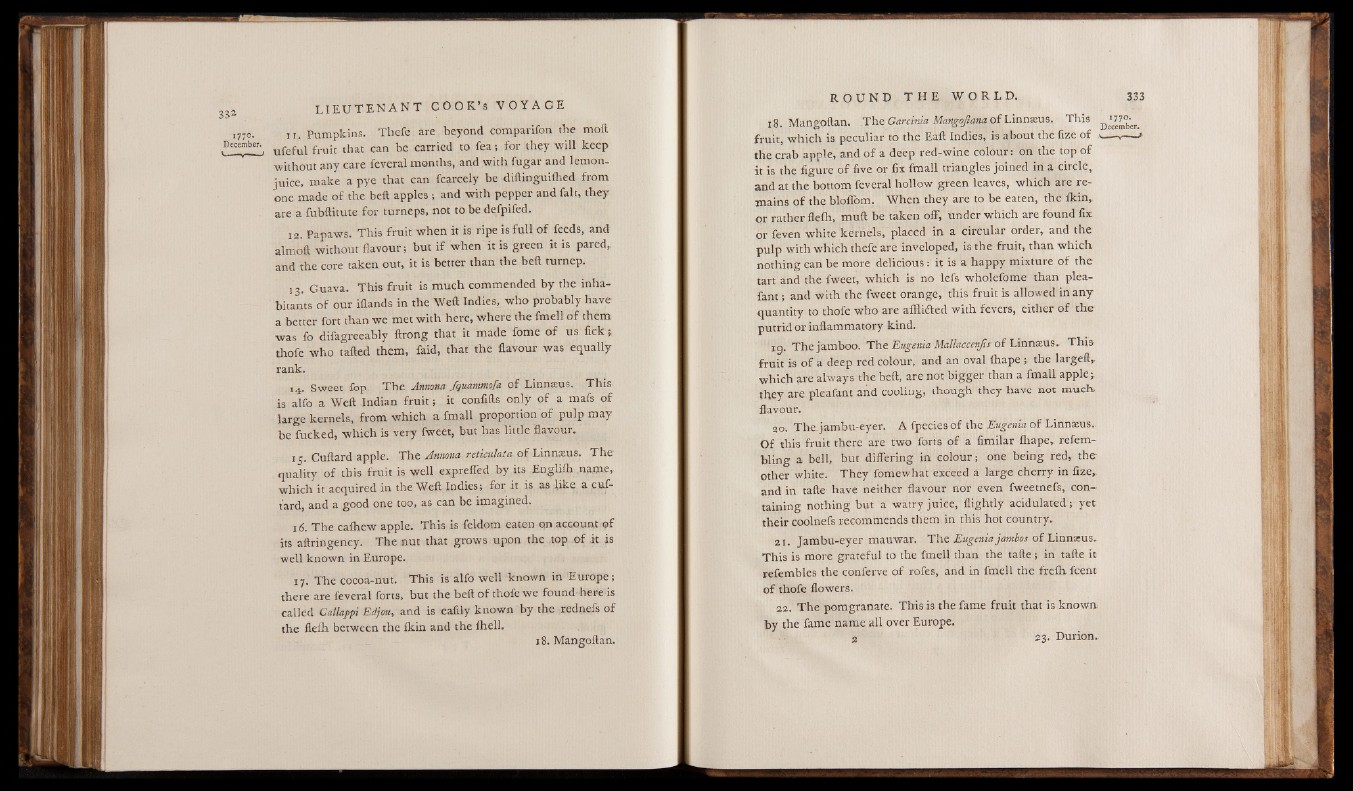
1770. 11. Pumpkins. Thefe are beyond companion the moil
.December.^ ufeful fruk that can be carried to fea; for they will keep
without any care feveral months, and with fugar and lemon-
juice, make a pye that can fcarcely be diftinguilhed from
one made of the beft apples ; and with pepper and fait, they
are a fubftitute for turneps, not to be defpifed.
1 a. Papaws. This fruit when it is ripe is full of feeds, and
almoft without flavour; but if when it is green it is pared,,
and the core taken out, it is better than the beft turnep.
13. Guava. This fruit is much commended by the inhabitants
of our iflands in the Weft Indies, who probably have-
a better fort than we met with here, where the fmell of them
was fo difagreeably ftrong that it made fome of us fick
thofe who tailed them, faid, that the flavour was equally
rank.
14. Sweet fop. The Annona fqmmmofa of Linnaeus. This
is alfo a Weft Indian fru it; it confifts only of a mafs of
large kernels, from which a fmall proportion of pulp may
be fucked, which is very fweet, but has little flavour.
15. Cuftard apple. The Jmuma reticulata of Linnaeus. The
quality of this fruit is well exprefied by its Englilh .name,
which it acquired in the Weft Indies; for it is as like a cuf-
tard, and a good one too, as can be imagined.
16. The cafhew apple. This is feldom eaten on account of
its aftringency. The nut that grows upon the top of it is
•well known in Europe.
17. The cocoa-nut. This is alfo well known in Europe;
there are feveral forts, but the beft of thofe we found'here-is
called Callappi Edjou, and is eafily known by the rednefs of
the flefli between the Ikin and the lhell.
18. Mangoftan.
R O U N D T H E WOR LD. 333
18. Mangoftan. The Garcinia Mangofmna of Linnaeus. This
fruit, which is peculiar to the Eaft Indies, is about the fize of <--------->
the crab apple, and of a deep red-wine colour: on the top of
it is the figure of five or fix fmall triangles joined in a circle,
and at the bottom feveral hollow green leaves, which are remains
of the blofiom. When they are to be eaten, the Ikin,
or rather flelh, muft be taken off, under which are found fix
or feven white kernels, placed in a circular order, and the
pulp with which thefe are inveloped, is the fruit, than which
nothing can be more delicious : it is a happy mixture of the
tart and the fweet, which is no lefs wholefome than plea-
fant; and with the fweet orange, this fruit is allowed in any
quantity to thofe who are alllicted with fevers, either of the
putrid or inflammatory kind.
19. Thejamboo. The Eugenia Mallaccenfur of Linnxeus. This
fruit is of a deep red colour, and an oval Ihape ; the largeft,.
which are always the beft, are not bigger than a fmall apple;,
they are pleafant and cooling, though they have not much
flavour.
so. The.jambu-eyer. A fpecies of the Eugenia o f Linnaus..
Of this fruit there are two forts of a fimilar Ihape,. refem-
bling a bell, but differing in colour; one being red, the-
other white. They fomewhat exceed a large cherry in fize,.
and in tafte have neither flavour nor even fweetnefs, containing
nothing but a watry juice, flightly acidulated; yet
their eoolnefs recommends them in this hot country.
21. Jambu-eyer mauwar. The Eugenia jambos of Linnatus.
This is more grateful to the fmell than the tafte; in tafte it
refembles the conferve of rofes, and in fmell the frelh feent
of thofe flowers.
22. The pomgranate. This is the fame fruit that is known
by the fame name all over Europe.
s 23. Durion.